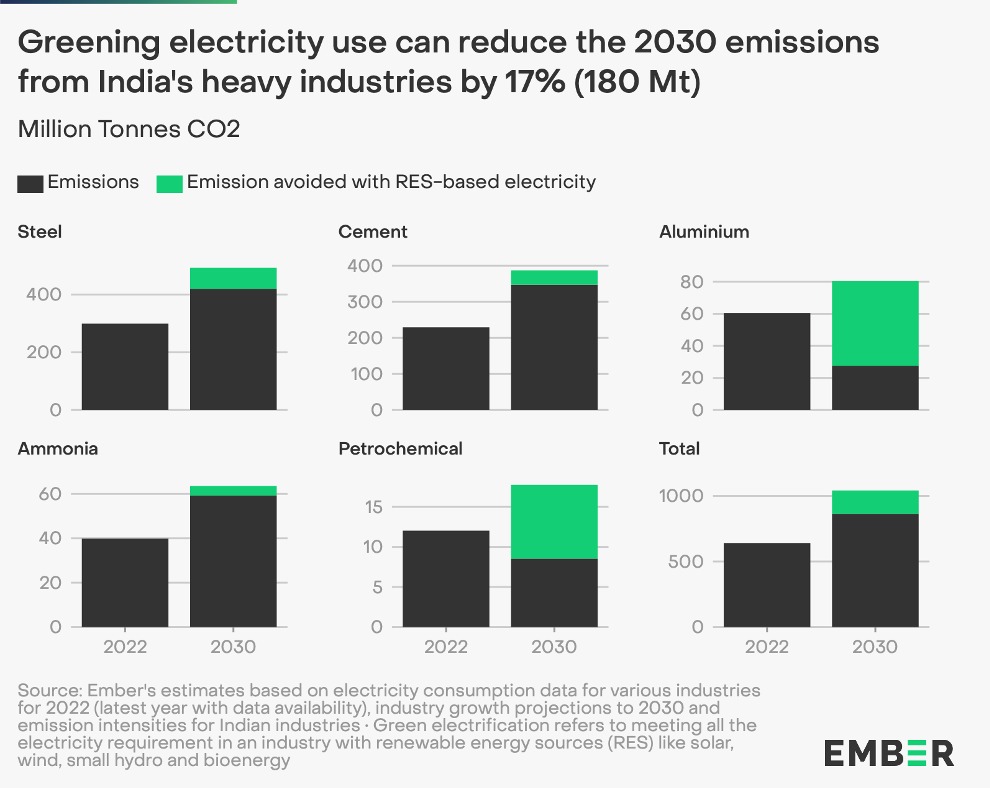
Dr. Seema JAved
As a major player in the global economy, India stands as an integral point of economic development and environmental responsibility. However, India is also the world’s third-largest emitter of CO2, after China and the US.
A new report from the energy think tank Ember highlights the role of renewable electrification in avoiding 17% of the carbon emissions from India’s heavy industry by 2030.

This report indicates possible near and long term strategies to smash emissions as India negotiates with the EU bloc on mechanisms to comply with the Carbon Border Adjustment Mechanism (CBAM). CBAM is a regulatory framework that imposes a carbon tariff on imports to the EU.
he EU has decided to impose a carbon tax known as the Carbon Border Adjustment Mechanism (CBAM), effective from January 1, 2026, on the import of 7 carbon-intensive sectors including:
1. Steel products
2. Iron and iron ore concentrates
3. Cement
4. Aluminum products
5. Fertiliser
6. Hydrogen
7. Electrical energy.
Most consider CBAM as “discriminatory” and a “trade barrier” that would hit not only Indian exports but also those of many other developing nations. The tariff is as high as 20-35% on imports of these high-carbon goods.
To fully decarbonise their electricity use and remain competitive in the global market, India’s heavy industries require 120 GW of dedicated renewable energy capacity by 2030. The report focuses on the steel, cement, petrochemicals, aluminium and ammonia sectors. Decarbonising these emission-intensive “heavy” industries can significantly benefit both India’s industrial sector and renewable energy ecosystem.
Currently, 11% of energy consumption in these heavy industries comes from electricity, with the rest from fossil fuel-based thermal energy. Based on industry growth projections, electricity demand for heavy industries is expected to rise by 45%. Meeting this increased demand with renewable energy could help to avoid 180 million tons (Mt) of CO2, equivalent to the total annual emission of the Netherland.
Duttatreya Das, an independent consultant and the report’s lead author said: ”Besides being one of the most promising levers for decarbonising industries, renewable based electrification offers multiple co-benefits. It allows industries to benefit from low cost renewable power, improves grid flexibility, and most importantly, improves air quality within industrial facilities. Switching to renewables immediately and ensuring clean air within industrial premises needs to be a people-first strategy for heavy industries.”
For deep decarbonisation of industries in the longer run, the report finds that it is crucial that key technologies to electrify thermal processes become commercially viable. If these new technologies and the government’s green hydrogen mission succeed, the share of electricity in the industrial energy mix could triple by 2050, reaching approximately 700 GW and avoiding 737Mt of emissions. However, advancing these technologies to achieve commercial viability and widespread deployment remains a challenge.
Green electrification offers a pathway for industries to meet increasing national and international emission regulations. The declining costs of electricity sourced from renewables present economic advantages, especially in India where high tariffs result from cross subsidies. Industries stand to gain from primary energy savings and protection from volatile fuel prices.
Moreover, the rising demand for renewables in industrial decarbonisation can attract large-scale investments in renewable energy projects, creating new jobs and invigorating India’s renewable energy ecosystem by integrating hydrogen into the energy mix.
Immediate adoption of green electrification offers a win-win solution. It facilitates compliance with emission regulations, provides economic benefits and supports India’s renewable energy ambitions. This transition is essential for the sustainable growth of India’s heavy industries and broader environmental sustainability.
Aditya Lolla, Asia Programme Director at Ember, said: “With emissions-related trade regulations like CBAM are expected to take effect soon, understanding the potential for near-term emission reductions is crucial for Indian heavy industries. Renewables-based electrification also offers multiple co-benefits to India’s wider energy ecosystem. It can open up multi-million dollar private investment opportunities, stimulate India’s clean energy manufacturing sector and propell India towards becoming a global leader in clean energy. ”
 Jubilee Post News & Views
Jubilee Post News & Views





